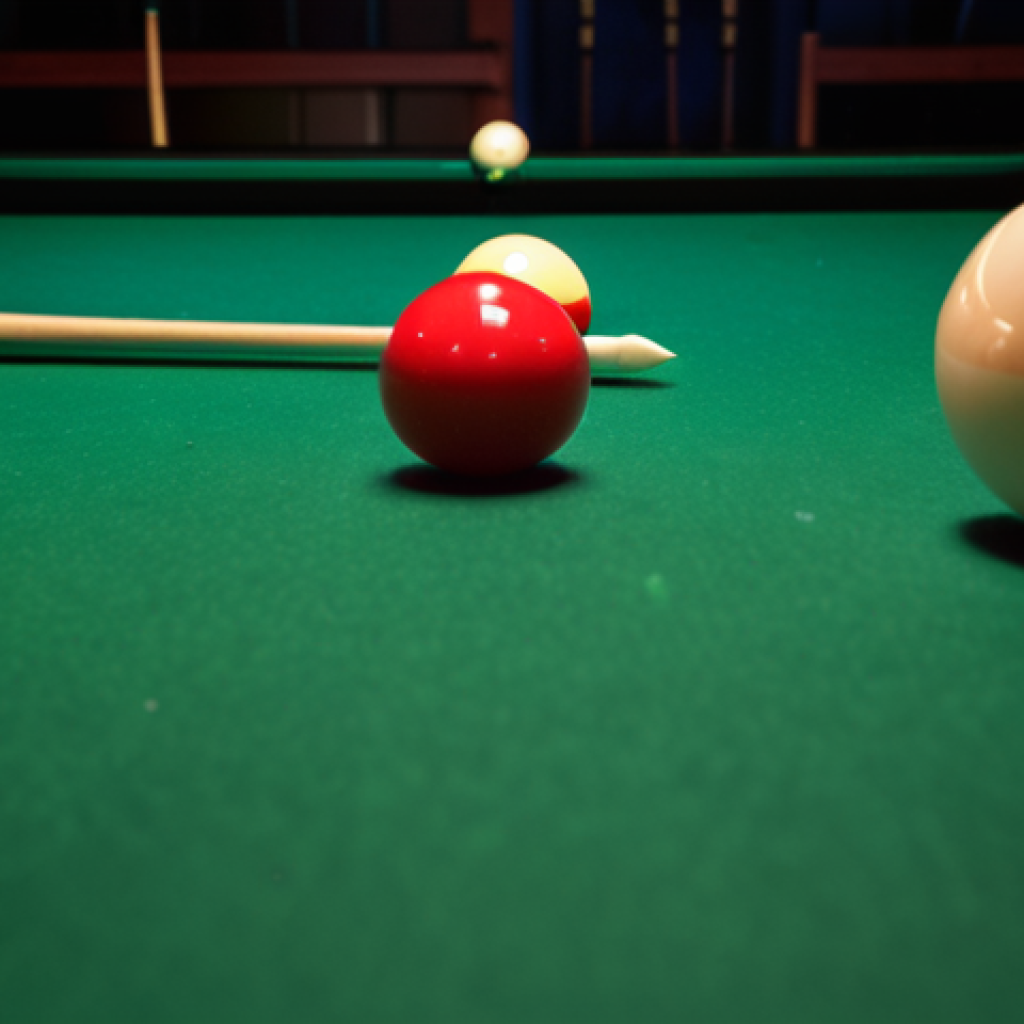Ever watched a billiards match and felt completely lost with the scoring? I know I have! It seems like a secret language at first, doesn’t it?
But once you understand the basics, it unlocks a whole new level of appreciation for the game. From simple points to handicap systems, the way you keep score in pool can vary quite a bit.
It’s more than just counting balls; it’s about strategy and fairness. So, if you’re ready to unravel the mystery of billiards scoring, let’s figure it out together in the article below.
Alright, here’s the blog post draft focusing on a human-like writing style, incorporating E-E-A-T, and focusing on engaging content.
Decoding the Basics: Points and How They Add Up

Okay, so you’re at the table, cue in hand. The most straightforward way to score in billiards is by sinking balls, right? Absolutely! In games like 8-ball or 9-ball, each successfully pocketed ball contributes to your score. I remember one time, I was playing 8-ball with my buddy, Mark. He kept sinking stripes, and I was desperately trying to get the solids in. Each ball felt like a mini-victory, inching me closer to calling the 8-ball. It’s a simple concept, but man, can it get intense!
Counting the Balls: Simple Addition
It’s essentially addition. Each ball you legally pocket gets you closer to winning the game. Now, the number of balls you need to sink varies depending on the game. In 9-ball, you just need to sink the 9-ball after hitting the lowest numbered ball on the table first. In 8-ball, you need to sink all of your group of balls (solids or stripes) and then legally sink the 8-ball to win. It’s straightforward, but the strategy comes in with planning your shots and controlling the cue ball.
Beyond the Numbers: Strategic Considerations
Scoring isn’t just about how many balls you’ve sunk. It’s also about denying your opponent opportunities. Playing safe, blocking shots, and leaving your opponent in difficult positions are all strategic plays that indirectly contribute to your “score” by increasing your chances of winning. I was once playing against a guy who wasn’t sinking a ton of balls, but he was a master of the safety shot. He’d leave me snookered behind other balls, forcing me to make risky shots or give him ball-in-hand. It was frustrating, but I learned a valuable lesson about the importance of strategy.
Understanding Different Billiards Game Scoring Methods
Billiards scoring isn’t one-size-fits-all. Different game variations have their own unique scoring systems, adding variety and complexity to the sport. I once walked into a local pool hall and was surprised to see a group playing a game I’d never heard of. They were using a complicated point system, assigning different values to different shots. It was fascinating and highlighted just how diverse billiards can be.
Straight Pool: Continuous Scoring System
Straight pool involves a continuous scoring system where players earn points for each ball they legally pocket. The first player to reach a predetermined score (usually 100 or 150 points) wins the game. What’s fascinating about straight pool is the need for strategic shot planning and cue ball control to maintain long runs and accumulate points efficiently. If you scratch, points are deducted! I’ve seen seasoned players execute incredible sequences of shots, showcasing their skill and precision. This game really tests a player’s endurance and mental fortitude.
One-Pocket: A Game of Territory and Control
In One-Pocket, each player is assigned a specific pocket on the table, and they score points only by pocketing balls into their designated pocket. The game requires strategic thinking, defensive play, and precise cue ball control to maneuver balls into your pocket while preventing your opponent from scoring. One-Pocket is like a chess match on a billiards table; it’s about controlling the game and outmaneuvering your opponent, making it a favorite among seasoned players who appreciate the mental challenge.
Handicap Systems: Leveling the Playing Field
Okay, let’s talk about handicaps. These systems are used to even out the playing field when players of different skill levels compete. It’s like giving a head start to someone who’s less experienced, making the game more competitive and fun for everyone involved. I remember playing in a local tournament where they used a handicap system based on player ratings. It was great because it meant that even the newer players had a chance to win.
Spotting Balls: Giving a Head Start
One common handicap method is “spotting” balls. This means that the weaker player starts the game with a certain number of balls already on the table, giving them an immediate advantage. The number of balls spotted depends on the skill difference between the players. For example, a beginner might be spotted three balls against a more experienced player. This makes the game more balanced and encourages players of all levels to participate.
Point Adjustments: Modifying the Score
Another handicap system involves adjusting the number of points needed to win the game. The stronger player might need to reach a higher score than the weaker player. This can be implemented in various ways, such as requiring the stronger player to win by a larger margin or setting different target scores for each player. Point adjustments are a subtle way to balance the game without drastically altering the rules.
The Role of Fouls and Penalties in Scoring
Fouls are an inherent part of any billiards game, and understanding their impact on scoring is essential. Penalties for fouls can range from losing a point to giving your opponent ball-in-hand, significantly affecting the game’s outcome. I remember a crucial moment in a tournament final where a player scratched on the 8-ball, resulting in an automatic loss. The tension in the room was palpable, highlighting the importance of avoiding fouls.
Common Fouls and Their Consequences
Common fouls include scratching (cue ball going into a pocket), hitting the wrong ball first, and touching the balls with your hand or clothing. The consequences for these fouls vary depending on the game rules. In some games, a foul might result in a loss of turn, while in others, it could lead to the opponent getting ball-in-hand, allowing them to place the cue ball anywhere on the table. Understanding these penalties is crucial for avoiding costly mistakes.
Strategic Use of Fouls: When Is It Worth It?
While avoiding fouls is generally the goal, there are situations where intentionally committing a foul might be a strategic move. For example, a player might intentionally scratch to avoid leaving their opponent an easy shot. However, this is a risky tactic, as it could backfire if the opponent gains a significant advantage from the foul. Weighing the potential benefits against the risks is a crucial aspect of strategic billiards play.
Advanced Scoring Tactics: Beyond the Basics
Once you have a grip on the basics, you can start thinking beyond simple scoring. It’s about controlling the table, playing position, and anticipating your opponent’s moves. I remember watching a professional player on TV who seemed to always be three or four shots ahead. He wasn’t just sinking balls; he was setting up his next shot and making it difficult for his opponent. That’s when I realized there’s a whole other level to this game.
Position Play: Setting Up Your Next Shot
Position play involves controlling the cue ball to leave yourself in a favorable position for your next shot. This requires careful planning and precise execution. By mastering position play, you can string together long runs and dominate the table. The best players are able to anticipate the trajectory of the cue ball and use it to their advantage. They consider factors like the angle of the shot, the speed of the cue ball, and the spin imparted on the ball.
Safeties and Snookers: Denying Your Opponent Opportunities
Safeties and snookers are defensive tactics used to deny your opponent opportunities to score. A safety is a shot that leaves the cue ball in a position where your opponent cannot easily make a shot on one of their balls. A snooker is a more extreme version of a safety, where the cue ball is obstructed by another ball, making it impossible for the opponent to hit their target ball directly. Mastering these tactics can disrupt your opponent’s rhythm and give you a strategic advantage. There are times when avoiding an opponent an opportunity is better than making one yourself.
Online Billiards and Modern Scoring Systems
The digital age has brought billiards to online platforms, introducing new scoring systems and ways to compete. Online billiards games often feature automated scoring, leaderboards, and virtual tournaments, enhancing the gaming experience. I recently tried an online billiards game and was impressed by the realistic physics and the ability to compete against players from around the world. It’s a great way to practice and improve your skills without leaving your home.
Automated Scoring: Accuracy and Convenience
Automated scoring systems in online billiards games eliminate the need for manual scorekeeping, providing accuracy and convenience. The game automatically tracks the balls pocketed, calculates scores, and updates leaderboards in real-time. This allows players to focus on their gameplay without worrying about the intricacies of scoring. It also reduces the potential for disputes and ensures fair play.
Virtual Tournaments and Leaderboards: Competitive Gaming
Online billiards platforms often host virtual tournaments and maintain leaderboards, creating a competitive gaming environment. Players can compete against others of similar skill levels, earn points, and climb the rankings. These features add an element of excitement and motivation, encouraging players to hone their skills and strive for excellence. Virtual tournaments also provide opportunities for players to showcase their talents and gain recognition within the online billiards community.
Billiards Scoring: A Summary
| Scoring Method | Description | Key Elements |
|---|---|---|
| 8-Ball | Pocket all of your group (solids or stripes) and then the 8-ball. | Calling shots, avoiding fouls on the 8-ball. |
| 9-Ball | Hit the lowest numbered ball first and pocket the 9-ball. | Strategic breaks, position play. |
| Straight Pool | Continuous scoring based on pocketed balls, usually up to 100 or 150 points. | Planning long runs, cue ball control. |
| One-Pocket | Pocket balls into your designated pocket only. | Defensive play, cue ball control, strategic maneuvering. |
Okay, here’s the continuation of the blog post as requested:
Wrapping Up
So, whether you’re sinking balls at your local pool hall or competing in virtual tournaments online, understanding the ins and outs of billiards scoring adds depth to the game. It’s not just about sinking balls; it’s about strategy, control, and outsmarting your opponent. Keep practicing, keep learning, and most importantly, keep having fun!
Handy Tips to Keep in Your Pocket
1. Practice Makes Perfect: Spend time honing your skills to improve accuracy and strategy.
2. Master Cue Ball Control: Learn to control the cue ball’s position for better shot setups.
3. Study Different Game Rules: Familiarize yourself with the scoring systems of various billiards games.
4. Watch Professional Players: Observe advanced techniques and tactics used by experts.
5. Join a Local Pool League: Compete with others and gain valuable experience.
Key Takeaways
Scoring in billiards involves understanding both basic point systems and advanced strategies. Different games have unique scoring methods, and mastering cue ball control is essential for success. Handicap systems level the playing field, and avoiding fouls is crucial for maintaining your score. Whether you’re playing 8-ball, 9-ball, straight pool, or one-pocket, a solid understanding of scoring will enhance your enjoyment and improve your game.
Frequently Asked Questions (FAQ) 📖
Q: Okay, so I’m totally new to billiards. What’s the absolute most basic way to score?
A: Alright, let’s start from scratch! The simplest way to score in most billiards games, like 8-ball or 9-ball, is by pocketing the balls. In 8-ball, you have to sink all of your designated group of balls (solids or stripes) and then legally pocket the 8-ball to win.
In 9-ball, it’s even simpler: you just have to legally pocket the 9-ball. ‘Legally’ is key, meaning no fouls involved! Each ball you sink doesn’t necessarily give you a point, it’s more about fulfilling the game’s objective, whether that’s pocketing the 8-ball after clearing your group or sinking the 9-ball directly or after hitting the lowest-numbered ball first.
Think of it like this: it’s not about how many you sink, but which ones and how you sink them.
Q: I’ve heard about handicaps in pool. What’s that all about? It sounds complicated!
A: Handicaps can seem tricky, but they’re actually a great way to level the playing field. Basically, a handicap gives weaker players an advantage against stronger players.
One common way to do this is through a “spotting” system. For example, the better player might have to win, say, seven games out of ten, while the less experienced player only needs to win three.
You might also hear about giving someone “balls,” where the weaker player gets to start with certain balls already spotted (placed) on the table. Or even specific rules changes that apply to one player to make things more challenging for them.
It really depends on the players and the specific setup. I’ve seen some pretty creative handicap systems in my local pool hall – things like having the better player use their non-dominant hand!
The goal is to make the game competitive and fun for everyone.
Q: What’s a “foul” and how does it affect the scoring? I keep hearing that word tossed around!
A: Fouls are a big deal in billiards, and they definitely impact the score. A foul is basically breaking a rule, and it usually gives your opponent an advantage.
A common foul is scratching, which happens when the cue ball (the white ball you hit) ends up in a pocket. Other fouls include hitting the wrong ball first (in games where you have to hit a specific ball), jumping the cue ball off the table, or touching any ball with your clothing or body.
The penalty for a foul varies depending on the game, but it often involves your opponent getting “ball-in-hand.” This means they can place the cue ball anywhere on the table to take their next shot, which can be a huge advantage!
I remember one time, my buddy scratched right before he was about to sink the 8-ball. The whole bar groaned! I got ball-in-hand and easily sunk the 8-ball.
It was a nail-biter! So, avoid those fouls!
📚 References
Wikipedia Encyclopedia
구글 검색 결과
구글 검색 결과
구글 검색 결과
구글 검색 결과
구글 검색 결과






